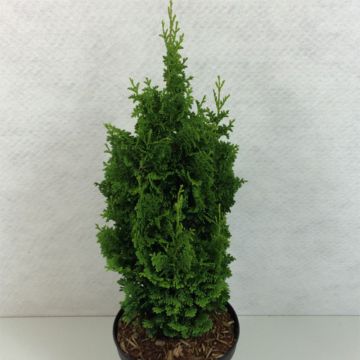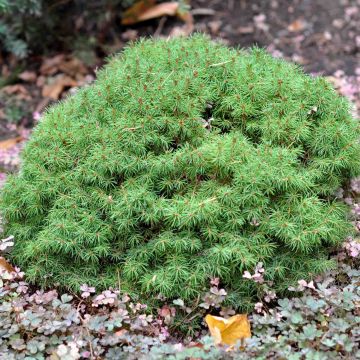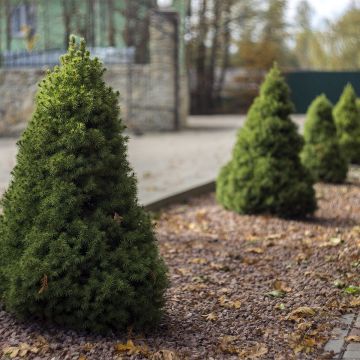

Thuja occidentalis Fire Chief - Canadian Arborvitae


Thuja occidentalis Fire Chief - Canadian Arborvitae


Thuja occidentalis Fire Chief - Canadian Arborvitae


Thuja occidentalis Fire Chief - Canadian Arborvitae
Thuja occidentalis Fire Chief - Canadian Arborvitae
Thuja occidentalis Fire Chief
Eastern White Cedar, Northern White Cedar, American Arborvitae, Eastern Arborvitae
Special offer!
Receive a €20 voucher for any order over €90 (excluding delivery costs, credit notes, and plastic-free options)!
1- Add your favorite plants to your cart.
2- Once you have reached €90, confirm your order (you can even choose the delivery date!).
3- As soon as your order is shipped, you will receive an email containing your voucher code, valid for 3 months (90 days).
Your voucher is unique and can only be used once, for any order with a minimum value of €20, excluding delivery costs.
Can be combined with other current offers, non-divisible and non-refundable.
Home or relay delivery (depending on size and destination)
Schedule delivery date,
and select date in basket
This plant carries a 24 months recovery warranty
More information
We guarantee the quality of our plants for a full growing cycle, and will replace at our expense any plant that fails to recover under normal climatic and planting conditions.
Would this plant suit my garden?
Set up your Plantfit profile →
Description
The Thuja occidentalis 'Fire Chief' is a very graphic small conifer that naturally forms a pretty, rounded mass and compact appearance, without the need for any pruning. Its quite fine foliage is very structured, yellow in spring, turning green in summer, before taking on a rich warm coppery hue in autumn. Evergreen, it is decorative in all seasons. Its slow growth and small size allow for many uses, in a rockery, as a standalone plant, in a border with shrubs, or even in a large pot near an entrance.
The Thuja occidentalis, also known as Eastern Arborvitae or White Cedar, is sometimes called Eastern White Cedar or Broom. It is an evergreen conifer of the Cupressaceae family native to the northeastern North America. It is distributed over a wide geographic area that perfectly reflects the plasticity of its living conditions, from swamps to cliffs, all hostile environments that discourage many other competing species. In nature, it reaches a height of 15 to 20 m (49 to 66ft), adopting a beautiful conical habit, and a trunk covered with a very decorative, reddish-brown peeling bark. It is a very hardy species, well adapted to temperate climates and poor, moist or occasionally dry soils. Its almost non-decaying, light, fragrant and easily flammable wood lends itself to many uses. It has given rise to more than 300 cultivars that have been selected for their ornamental qualities. The dwarf and compact forms are more water-efficient.
The variety 'Fire Chief' is a mutation derived from the famous variety 'Rheingold', a star among the Arborvitaes. It is distinguished by its smaller size and its very regular spherical habit. Its growth is slow, so it will reach about 70 cm in all directions at the age of ten years and 1 m (33 and 3ft) at maturity. The foliage is golden yellow in spring, then the new shoots turn green and take on warm coppery colors, or even dark red in autumn. Far from the monotony that conifers are sometimes criticized for, this evergreen and changing foliage is decorative all year round. Moreover, this miniature conifer is easy to grow. It grows in most soils, neutral to slightly calcareous, ideally moist, although it tolerates relative drought. Extremely hardy, it withstands -30 °C in well-drained soil.
The 'Fire Chief' Western Arborvitae will find its place in a small garden and a not too arid rockery or even in a beautiful container on the terrace or balcony. In this case, it will need to be regularly watered to prevent the substrate from drying out and the roots from suffering. It will create a permanent spectacle with the small Cotinus coggygria Young Lady, a miniature smoke bush with also changing foliage colors, and abundant pale pink feathery flowering. This small conifer loves large stones, the geometric lines of pools or buildings, and masonry works. It can also be associated with grasses, which are very complementary, as well as with other small conifers with colorful foliage, such as the delightful Picea sitchensis Silberzwerg with its bluish-gray needles and silvery undersides. Our little Fire Chief will also elegantly contrast with the astonishing Abies koreana Kohout's Icebreaker®, a dwarf Korean fir with a unique appearance with its silvery needle undersides.
Report an error about the product description
Thuja occidentalis Fire Chief - Canadian Arborvitae in pictures




Plant habit
Foliage
Botanical data
Thuja
occidentalis
Fire Chief
Cupressaceae
Eastern White Cedar, Northern White Cedar, American Arborvitae, Eastern Arborvitae
Cultivar or hybrid
Other Thuya - Thuja
View all →Planting and care
The Thuja occidentalis 'Fire Chief' should be planted from September to November and from February to April in deep, ordinary, but loose and light soil. The soil can be neutral or even slightly alkaline, but not too arid. It only fears extreme temperatures and prolonged drought, although it can tolerate occasional dryness once well established.
However, it requires a sunny exposure or possibly partial shade in hot climates to develop well. Soak the root ball well before planting, or better yet, soak it in a bucket to thoroughly saturate it with water. Optionally, add organic amendment at planting and water generously in the first years, and during prolonged drought. In very poor soil, you can apply a special conifer fertilizer every year in April and cultivate the soil in summer. This hardy conifer (up to at least -25 °C) does not require pruning.
Planting period
Intended location
Care
This item has not been reviewed yet - be the first to leave a review about it.
Similar products
Haven't found what you were looking for?
Hardiness is the lowest winter temperature a plant can endure without suffering serious damage or even dying. However, hardiness is affected by location (a sheltered area, such as a patio), protection (winter cover) and soil type (hardiness is improved by well-drained soil).

Photo Sharing Terms & Conditions
In order to encourage gardeners to interact and share their experiences, Promesse de fleurs offers various media enabling content to be uploaded onto its Site - in particular via the ‘Photo sharing’ module.
The User agrees to refrain from:
- Posting any content that is illegal, prejudicial, insulting, racist, inciteful to hatred, revisionist, contrary to public decency, that infringes on privacy or on the privacy rights of third parties, in particular the publicity rights of persons and goods, intellectual property rights, or the right to privacy.
- Submitting content on behalf of a third party;
- Impersonate the identity of a third party and/or publish any personal information about a third party;
In general, the User undertakes to refrain from any unethical behaviour.
All Content (in particular text, comments, files, images, photos, videos, creative works, etc.), which may be subject to property or intellectual property rights, image or other private rights, shall remain the property of the User, subject to the limited rights granted by the terms of the licence granted by Promesse de fleurs as stated below. Users are at liberty to publish or not to publish such Content on the Site, notably via the ‘Photo Sharing’ facility, and accept that this Content shall be made public and freely accessible, notably on the Internet.
Users further acknowledge, undertake to have ,and guarantee that they hold all necessary rights and permissions to publish such material on the Site, in particular with regard to the legislation in force pertaining to any privacy, property, intellectual property, image, or contractual rights, or rights of any other nature. By publishing such Content on the Site, Users acknowledge accepting full liability as publishers of the Content within the meaning of the law, and grant Promesse de fleurs, free of charge, an inclusive, worldwide licence for the said Content for the entire duration of its publication, including all reproduction, representation, up/downloading, displaying, performing, transmission, and storage rights.
Users also grant permission for their name to be linked to the Content and accept that this link may not always be made available.
By engaging in posting material, Users consent to their Content becoming automatically accessible on the Internet, in particular on other sites and/or blogs and/or web pages of the Promesse de fleurs site, including in particular social pages and the Promesse de fleurs catalogue.
Users may secure the removal of entrusted content free of charge by issuing a simple request via our contact form.
The flowering period indicated on our website applies to countries and regions located in USDA zone 8 (France, the United Kingdom, Ireland, the Netherlands, etc.)
It will vary according to where you live:
- In zones 9 to 10 (Italy, Spain, Greece, etc.), flowering will occur about 2 to 4 weeks earlier.
- In zones 6 to 7 (Germany, Poland, Slovenia, and lower mountainous regions), flowering will be delayed by 2 to 3 weeks.
- In zone 5 (Central Europe, Scandinavia), blooming will be delayed by 3 to 5 weeks.
In temperate climates, pruning of spring-flowering shrubs (forsythia, spireas, etc.) should be done just after flowering.
Pruning of summer-flowering shrubs (Indian Lilac, Perovskia, etc.) can be done in winter or spring.
In cold regions as well as with frost-sensitive plants, avoid pruning too early when severe frosts may still occur.
The planting period indicated on our website applies to countries and regions located in USDA zone 8 (France, United Kingdom, Ireland, Netherlands).
It will vary according to where you live:
- In Mediterranean zones (Marseille, Madrid, Milan, etc.), autumn and winter are the best planting periods.
- In continental zones (Strasbourg, Munich, Vienna, etc.), delay planting by 2 to 3 weeks in spring and bring it forward by 2 to 4 weeks in autumn.
- In mountainous regions (the Alps, Pyrenees, Carpathians, etc.), it is best to plant in late spring (May-June) or late summer (August-September).
The harvesting period indicated on our website applies to countries and regions in USDA zone 8 (France, England, Ireland, the Netherlands).
In colder areas (Scandinavia, Poland, Austria...) fruit and vegetable harvests are likely to be delayed by 3-4 weeks.
In warmer areas (Italy, Spain, Greece, etc.), harvesting will probably take place earlier, depending on weather conditions.
The sowing periods indicated on our website apply to countries and regions within USDA Zone 8 (France, UK, Ireland, Netherlands).
In colder areas (Scandinavia, Poland, Austria...), delay any outdoor sowing by 3-4 weeks, or sow under glass.
In warmer climes (Italy, Spain, Greece, etc.), bring outdoor sowing forward by a few weeks.


















































